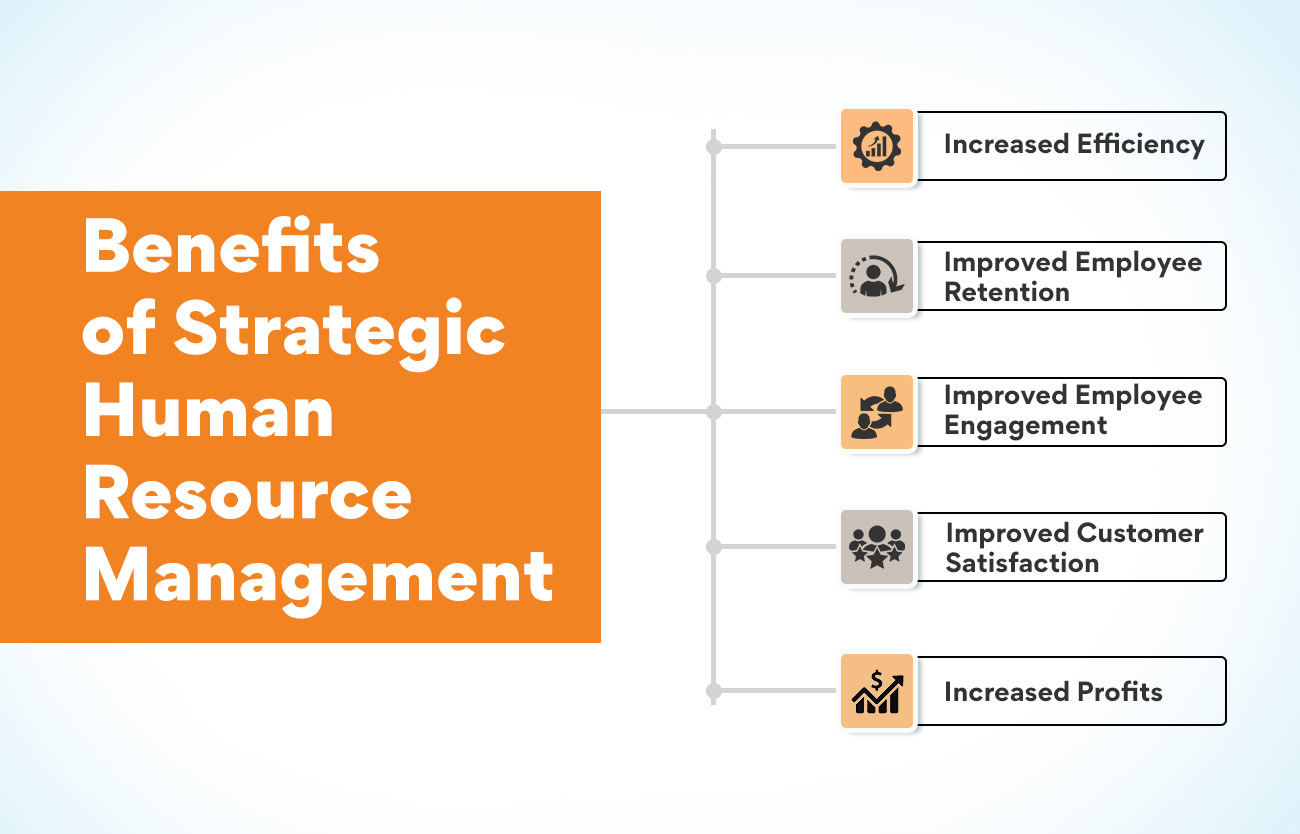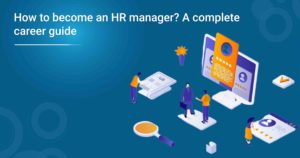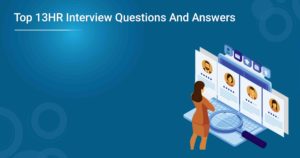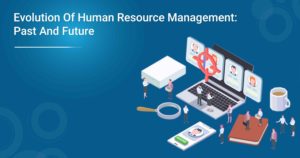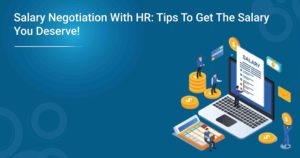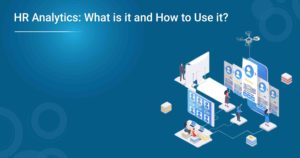Strategic HRM and Human Capital Management are two critical concepts in Human Resources. Strategic HRM is aligning the human resource strategy with the business strategy. Human capital management is the process of managing people as an investment.
The advantages of strategic HRM are that it allows businesses to manage their talent better, create a more engaged workforce, and improve organisational performance. The benefits of human capital management are that it allows businesses to attract better, develop, and retain talent and improve organisational performance.
Strategic human resource management (SHRM) involves planning, organising, leading, and controlling the resources and activities of a company to achieve strategic objectives. The goal of SHRM is to ensure that the company has the right people in the right places at the right time. This can be done by positioning employee goals with the company, creating a system where employees can give their best performance, and ensuring that employees are treated fairly. In this blog post, we will discuss strategic human resource management and give some examples of how it can be used in business.
Importance of Human Resource Management For Company’s Success
Human resource management is critical for the success of any company. The human resources department engages in attracting, sorting, hiring, and retaining the best talent. They also manage employee benefits, compensation, and training.
A company’s human resources (HR) strategy should align with its business strategy. The HR department should be the strategic partner with the business, working together to achieve the company’s goals.
Human resources fuels a company from within. After all, the human resource department handles a company’s most valuable asset – its people. Hence, it is essential to prioritise strategic human resource management.
A Glance Into SHRM
Strategic human resource management is a proactive and forward-thinking approach to managing an organisation’s most valuable asset – its people. To succeed, businesses must have a strategic plan for attracting, developing, and retaining top talent. This strategic approach ensures that HR initiatives are aligned with the overall business goals and objectives.
With SHRM, a business can create a comprehensive and integrated plan that covers all aspects of HR management, from recruiting and selection to training and development, compensation and benefits, employee relations, and diversity and inclusion. By taking a strategic approach to HR, businesses can create a competitive advantage with their best talents in place.
Businesses can use many different SHRM models and frameworks to guide their strategic planning. However, all SHRM models share some common elements, including a focus on strategic planning, alignment with business goals, and a comprehensive approach to HR management.
If you are interested in learning more about SHRM, we have a certificate course that will give you a deep insight into the matter. Check out our Post Graduate Certificate in Human Resource Management for more details.
Also Read: What is Strategic Human Resource Management? Definition and Examples
How Does Strategic Human Resource Management Work With Business Strategy?
Strategic human resource management creates a link between the human resource function and the strategic goals of the organisation to enhance business performance.
The human resource function must align with the strategic objectives of the organisation to be effective. The human resource department must clearly understand the organisation’s business strategy.
The HR department must also be able to identify the skills and competencies required to support the organisation’s business strategy. Once all the right skills and competencies have been identified, the HR department can begin to identify and attract candidates with the necessary skills and competencies.
It is the responsibility of HR professionals to develop and implement programs and policies that will support the organisation’s business strategy. For example, suppose the organisation’s business strategy is to become a market leader. In that case, the HR department might develop and implement programs that focus on developing employee skills and competencies that will help the organisation to achieve this goal.
The HR department must also be able to evaluate the effectiveness of the programs and policies that have been implemented. This evaluation process is essential to make sure that the programs and policies are supporting the organisation’s business strategy.
Strategic human resource management is a process that must be constantly adapted to the ever-changing needs of the organisation. It not only encourages a great mix of talents but also ensures they are working towards the growth of the company.
Benefits of SHRM
Several benefits are achieved through strategic human resource management. By aligning HR strategies with the overall business strategy, businesses can create a competitive advantage and improve organisational performance. Take a look at the top-most benefits of having a strong SHRM in place:
- Increased Efficiency
Strategic human resource management can lead to increased efficiency in the workplace. When HR strategies are aligned with business goals, it can help to eliminate waste and duplication of effort. It creates a trail for a more streamlined and efficient operation, saving the company time and money. It’s a no-brainer that happy and content employees are more productive.
By investing in the development of employees, businesses can ensure that they have the skills and knowledge necessary to be successful. A good strategic human resource management system will help identify employees’ training and development needs. This can lead to improved employee performance and increased efficiency.
- Improved Employee Retention
Another benefit of strategic human resource management is improved employee retention. When employees are allowed to grow and develop within the company, they are more likely to stay with the organisation. This can lead to increased employee loyalty and commitment, which can improve retention rates.
Additionally, strategic human resource management can help to create a positive work environment. It lowers turnover rates and improves employee retention. When employees are 100% satisfied and happy with their workplace and job profile, they are less likely to look for other opportunities.
- Improved Employee Engagement
Improved employee engagement will directly benefit the company. It automatically fosters increased profits for the company and a better bottom line. Employees who are engaged and engrossed in their work are more likely to be productive and efficient.
In addition, engaged employees are found to be satisfied with their jobs and stay with the company for the long haul. It can pave the way for improved employee retention and a decreased need for replacements.
- Improved Customer Satisfaction
When employees are appropriately managed and engaged, it will improve customer satisfaction. When customers are happy with their products or services, they are more likely to return and recommend the company to others. It can bring increased sales and revenue for the business
It is imperative to have a strategic human resource management system in place to improve customer satisfaction and open up new growth opportunities.
- Increased Profits
Last but not least, strategic human resource management can lead to increased profits for the company. When all of the above benefits are achieved, it will result in a more efficient and effective operation. This can steer to increased sales and revenue for the business.
Productive and proficient employees are tantamount to a successful company. Whether it is increased revenue or satisfied clientele, it is a win-win situation for a company that adopts SHRM. Strategic HR is a good place to start if you want to improve your company’s growth.
Not only is it ideal for a company’s growth, but strategic human resource management can also provide professionals with a superior edge in their careers. If you want to learn SHRM in detail and how to best utilise it, take a look at our Post Graduate Certificate in Human Resource Management and decide.
Also Read: Key Objectives of Human Resource Management
Examples of Strategic Human Resource Management From Leading Companies
Strategic human resource management is a process that helps organisations align their HR strategies with their overall business goals.
To find out how strategic HRM can be implemented in your organisation, it is helpful to look at examples from companies that have successfully used this approach.
Some of the most well-known companies that practice strategic HRM include Google, Facebook, CISCO, and Starbucks. Let’s discuss these companies’ SHRM in detail:
For years, Google has been ranked as the best company around the world to work for, and for all good reasons. It has been offering some amazing benefits to its employees that, in return, provide them with impeccable business results. They are known for their innovative HR practices, which include:
- Offering employees a “career sabbatical” of up to six months every four years
- Providing free food and childcare on site
- Offering comprehensive health benefits
- Encouraging employees to spend 20% of their time working on projects of their choosing
These benefits are not just perks – they are strategic HR decisions that help Google attract and retain the best talent. They also conduct regular HR feedback and employee data collection to understand what is working well and what needs to be improved.
In 2016, founders Larry Page and Sergey Brin said, “People operations are probably the most important thing we do.” This quote demonstrates how seriously Google takes strategic HRM.
Google is a great example of how strategic HRM can be used to create a positive work environment and attract top talent.
Facebook is another company that is known for its innovative HR practices, just like its business model. A few examples include:
- Offering employees $2000 to move closer to the Facebook office
- Providing free food and transportation to and from work
- Giving comprehensive health benefits
- Encouraging employees to take leave/break whenever required
They have brought the best talent in the industry by using strategic HRM practices. It not only kindles productivity but also keeps the work-life balance in check.
As a result, it helps them maintain a low turnover rate. Just like it has captured its customers’ hearts, Facebook is a dream workplace for many who made this company what it is today.
Starbucks
Starbucks is a global company known for its strong culture and commitment to its employees. Some of the strategic HR practices that they use include:
- Providing comprehensive health benefits
- Offering stock options to all employees
- Investing in employee development
- Creating a culture of respect and inclusion
- Fostering a work-life balance
- Providing opportunities of contributing to the community to employees
Starbucks has been successful in creating a strong culture and committed workforce. These strategic HR practices have helped create a positive work environment and retain employees.
CISCO
Cisco is an excellent example of strategic human resource management in action. Cisco has a set of HR strategies and policies in place that are designed to attract, retain, and develop the best talent. Some of the strategies are:
- Offering a variety of job opportunities and career growth paths
- Providing competitive salaries and benefits
- Offering training and development programs
- Creating a positive and supportive work environment
The company clearly understands its business goals and the role that its employees play in achieving those goals. By aligning its HR strategies with its business goals, Cisco has created a highly skilled and motivated workforce to help the company achieve its objectives.
These are just a few examples of strategic HRM in action. As you can see, strategic HRM is not just about providing good benefits and hiring the best talent. It’s about aligning your HR strategies with your business goals to create a highly skilled and motivated workforce to help you achieve your objectives.
Strategic Human Resource Management: Future Of A Thriving Business World
The strategic human resource management definition points to a promising future for those with the skills and knowledge to help businesses thrive. It is the foresighted planning of HR programs to align with and support an organisation’s business goals.
As the business world changes and grows, so must the HR strategies employed by companies if they wish to remain competitive. With a proactive and strategic approach to HR management, businesses can stay ahead of the curve, ensuring that their workforce is adequately equipped to meet future challenges.
There are many different strategic human resource management examples, but common HR strategies under this umbrella include workforce planning, talent management, and succession planning. By taking a strategic approach to HR, businesses can ensure that they have the right mix of talent on staff, that employees are adequately developed and trained, and that there is a plan in place for continuity in the event of fundamental personnel changes.
Strategic HRM and Business Performance
Human resource management plays a vital role in organisational success. Organisations can improve performance and competitiveness by aligning HR strategies with business goals. Strategic HRM is a process linking HRM with the organisation’s strategic objectives. Through this process, organisations can ensure that their human capital contributes to achieving business objectives.
There are several benefits of implementing strategic HRM in organisations:
- It helps to improve organisational performance.
- It enhances employee productivity and motivation.
- It attracts and retains talent within the organisation.
- It helps to create a positive work environment and culture within the organisation.
Strategic HRM and People Analytics
Strategic human resource management (SHRM) is the proactive management of an organisation’s workforce to align with its overall strategy and business objectives. It includes all aspects of HR management, from recruiting to performance management and employee development.
People analytics is a data-driven approach to HR that uses data and analytics to improve decision-making around people-related issues. It can help organisations identify trends and patterns in employee behaviour, pinpoint areas for improvement, and make better decisions about things like compensation, benefits, and career paths.
When used together, SHRM and people analytics can give organisations a comprehensive view of their workforce and help them make informed decisions about how to best invest in their people.
SHRM Vs. HRM
SHRM vs HRM is a debate that has been ongoing for some time now. So, what is the difference? And what does each one entail?
Firstly, SHRM stands for Strategic Human Resource Management. This type of management focuses on long-term organisational goals and objectives. It considers the company’s mission and vision when making HR policies and practices decisions. SHRM aims to align the organisation’s human resources with its strategic goals.
On the other hand, HRM stands for Human Resource Management. This type of management is more operational. It focuses on the day-to-day management of employees. HRM includes activities such as recruitment, training, and performance management. While HRM is essential for ensuring that employees are productive and happy, it doesn’t always consider the organisation’s long-term goals.
Assessing Staff And Skills – Step To Develop Strategic HRM Plan
An organisation’s human resources (HR) are its people. Strategic HR management is the proactive management of an organisation’s human resources to align with and support the organisation’s business objectives. A key component of SHRM is workforce planning, which is assessing staff and skills needs to identify gaps between an organisation’s current workforce and future workforce requirements.
Workforce planning is a continuous process that should be revisited regularly to ensure that an organisation’s HR strategy remains aligned with its business goals. The main measures in the workforce planning process are:

- Assessing staff and skills needs: This involves identifying the skills and competencies required to meet future business needs. It also includes assessing the current workforce to identify gaps between existing skills and future needs.
- Planning for staff and skills development: This step involves developing strategies to close gaps between current and future workforce requirements. It may include training and development programs, succession planning, or recruiting new talent.
- Implementing plans: This step involves putting the plan into action by implementing the strategies developed in Step 2. This may include developing new policies and procedures or investing in new technologies or training programs.
- Monitoring progress: This final step involves monitoring the results of the workforce planning process to assess whether the desired outcomes have been achieved. It may include conducting regular surveys or tracking data such as employee turnover rate or engagement levels.
Developing Competitive Pay – Step To Develop Strategic HRM Plan
Strategic human resource management helps organisations create and sustain a competitive advantage in the marketplace by aligning their human resources with their business strategy.
The first step in developing an SHRM plan is to assess the organisation’s current situation. It includes understanding the organisation’s business model, competitive environment, and internal strengths and weaknesses. Once the current situation has been assessed, the next step is to develop a vision for the future. This vision should be based on where the organisation wants to be in terms of its business goals and objectives.
After the vision has been developed, the next step is to create a strategy for how to achieve this vision. The strategy should consider all factors that will impact the organisation’s ability to achieve its goals, including its human resources. Once the strategy has been developed, it should be implemented through HR policies and practices that support it. Finally, the success of the SHRM plan should be supervised and evaluated on an ongoing basis to ensure that it achieves its desired results.
Steps To Develop Strategic HRM Plan
Understanding The Competition
The first step in developing a Strategic HRM Plan is understanding the competition. What are the other companies in your industry doing? How do their HR strategies compare to yours? What are their strengths and weaknesses?
Once you have a better knowledge of the competition, you can develop your own strategic HRM plan. Some things to consider are the following:
- What are your company’s strengths and weaknesses?
- What is your competitive advantage?
- What are the goals for the next five years?
- How will your HR strategy help you achieve these goals?
- What are the risks and problems associated with your HR strategy?
- How will you measure success?
Ascertaining The Recruitment Strategy
Ascertaining the recruitment strategy is the next step to developing a strategic human resource management (HRM) plan. The process of establishing the recruitment strategy includes understanding the organisation’s business model, determining the workforce requirements and designing the recruitment process.
Organisations need to clearly understand their business model before they can ascertain the recruitment strategy. The business model should be aligned with the organisational goals and objectives. Once the business model is understood, organisations can determine the workforce requirements. Workforce requirements include the number of employees, the skills and experience required, and the compensation and benefits package.
After determining the workforce requirements, organisations need to design the recruitment process. The recruitment process should be designed to attract qualified candidates who meet the workforce requirements. The recruitment process should also be designed to select candidates who are likely to be successful in the organisation.
Providing Training Development
To develop a Strategic HRM Plan, your organisation must provide employee training and development opportunities. This will ensure that your workforce can keep up with the ever-changing demands of the business world and that they can contribute to the organisation’s success.
Your training and development program should be designed to meet the requirements of your employees and should be based on their skills and abilities. It is also essential to tailor your program to your organisation’s specific goals and objectives.
Some things to keep in mind when designing a training and development program include the following:
- Assessing the current skill levels of your employees and determining what training is needed to help them improve.
- Creating a curriculum covering all job aspects, from basic skills to more advanced techniques.
- Select delivery methods best suited for your workforce (e.g., online courses, instructor-led classes, etc.).
- Offering incentives or rewards for employees who complete the training program.
By providing training and development opportunities for your employees, you can create a strategic advantage for your organisation. A well-trained workforce will be better equipped to handle the challenges of today’s business world and more likely to assist the success of your organisation.
What Are The Key Features of Strategic Human Resource Management?
SHRM is a process that helps organisations align their human capital with their strategic goals. The key features of this process include the following:
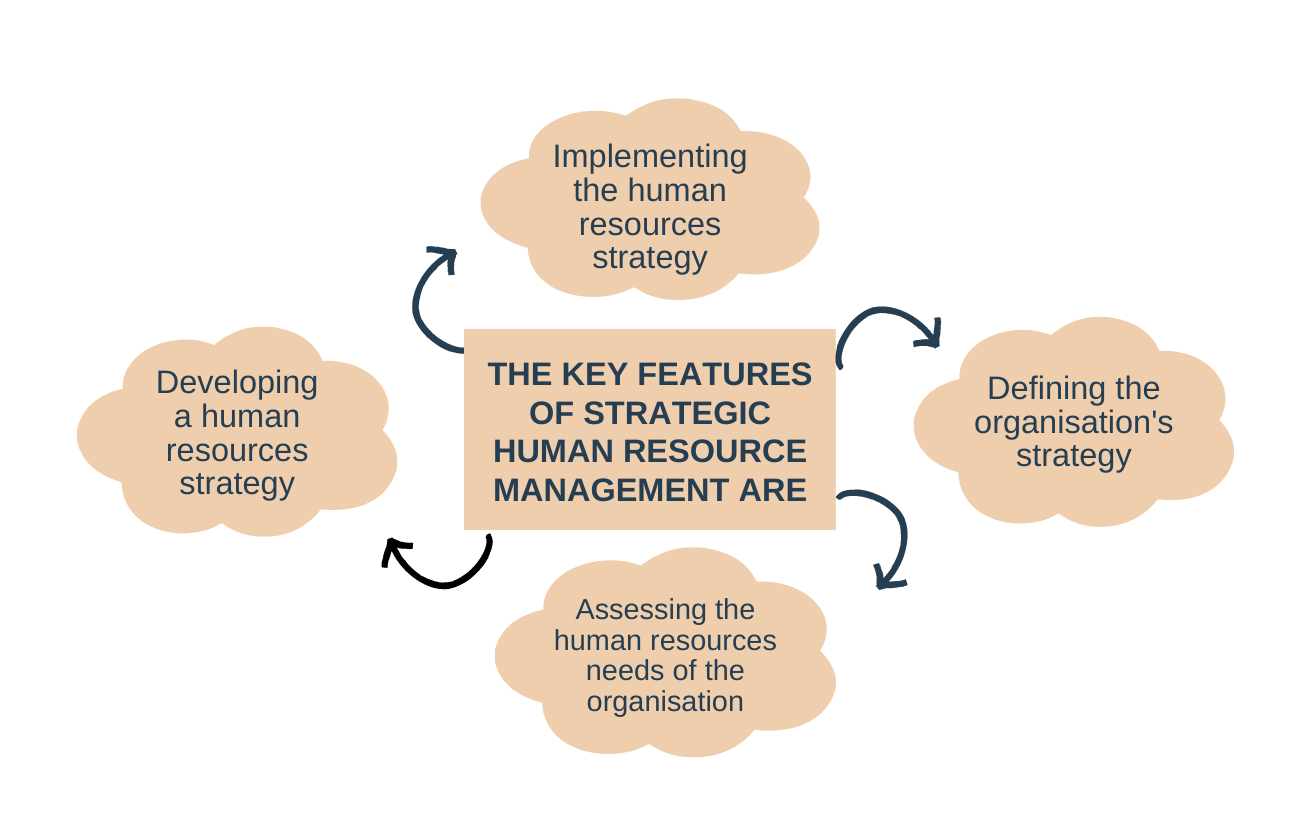
- Defining the organisation’s strategy: The first step in any strategic planning process is to define the organisation’s overall strategy. It includes setting objectives, identifying the company’s core competencies, and developing a plan for achieving the desired results.
- Assessing the human resources needs of the organisation: Once the organisational strategy is defined, the next step is to assess the organisation’s human resources needs. This includes conducting a workforce analysis to identify gaps in skills and knowledge and determining what type of talent will be required to achieve the strategic objectives.
- Developing a human resources strategy: Once the organisational and human resources needs have been assessed, it is time to develop a human resources strategy that will support the overall business strategy. This includes creating programs and policies to attract, develop, and retain the talent needed to succeed.
- Implementing the human resources strategy: The final step is to implement the human resources strategy. This includes putting programs and policies into place and ensuring that all organisation members follow them.
No doubt, human resource is a booming field to enter right now. If you’re interested in a strategic human resource management definition and examples, many resources are available to help you get started. Our Post Graduate Certificate in Human Resource Management is a great place, to begin with.
More Information:
Nature and Objectives of Human Resource Management
Evolution Of Human Resource Management: Past and Future
Difference Between Personnel Management And Human Resource Management







